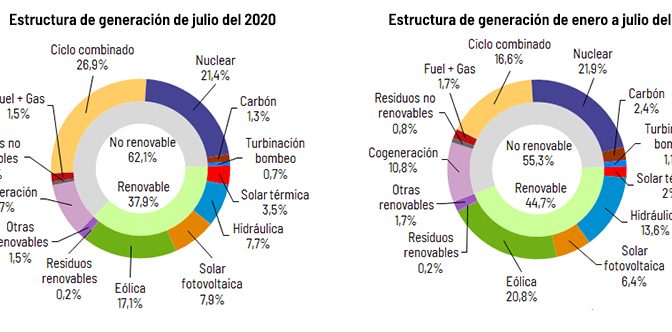Demand for electrical energy in Spain fell by 3.8% in July: wind energy produced 37.9%, concentrated solar power 3.5% and photovoltaic 7.9%

The demand for electrical energy decreased in the Balearic Islands by 26.8% and in the Canary Islands by 9.4% compared to the same month of 2019.
Solar photovoltaic produced 89.9% more than in July 2019 and registered a new monthly generation maximum nationwide, reaching 1,903 GWh.
Red Eléctrica de España publishes the electricity demand corresponding to July, the first full month once the alarm state is over due to Covid-19. In this context, the national electricity demand for July is estimated at 23,298 GWh, 3.8% lower than that registered in the same month of the previous year. If the effects of the calendar and temperatures are taken into account, the figure decreases 4.8% compared to July 2019.The decrease in July is less pronounced than in previous months compared to the same period in 2019, and continues to show a recovery in terms of energy consumption, given that during the period of the state of alarm (from March 15 to 21 June), demand was 13.3% lower in the Spanish electricity system compared to the same period in 2019.
In the first seven months of 2020, demand is estimated at 143,507 GWh, 7.5% less than in 2019. In this case, once the influence of calendar and temperatures has been corrected, demand is 7.6% lower to that registered in the same period of the previous year.
In the month of July and according to data estimated today, generation from renewable energy sources represented 37.9% of production. From January to July, renewable generation reaches 44.7% of the national electricity balance.
In this month, 60% of electricity production came from technologies that do not emit CO2 equivalent. With information available today, photovoltaic solar registered a new monthly generation maximum in July by producing 1,903 GWh, which represents an increase of 89.9% compared to July 2019. Its contribution to the generation structure was 7.9% of the total. For its part, wind generation in July reached 4,121 GWh, 19.8% more than the same period last year, and accounted for 17.1% of national production.
The demand for electrical energy falls by 2.9% in the peninsular electricity system
In the peninsular electricity system, the demand for July is estimated at 22,038 GWh, 2.9% lower than that registered in the same month of the previous year. If the effects of the calendar and the temperatures are taken into account, the demand is 3.9% lower than that of July 2019.
In the first seven months of 2020, the demand for electrical energy in the Peninsula is estimated at 135,903 GWh, 7.1% less than in 2019. In this case, once the influence of calendar and temperatures has been corrected, demand It is also 7.2% lower than that registered in the same period of the previous year.
During this month and according to estimated data today, 38.7% of the peninsular generation was of renewable origin and 61.9% came from technologies that do not emit CO2 equivalent. For its part, wind registered 3,966 GWh, 20.8% higher than in July last year, and contributed 17.2% to the mix.
Demand for electrical energy falls 26.8% in the Balearic Islands and 9.4% in the Canary Islands in July
In the Balearic Islands, the demand for electrical energy in July is estimated at 526,618 MWh, 26.8% lower than that registered in the same month of the previous year. If calendar effects and temperatures are taken into account, the figure decreases 25% compared to July 2019. In the first seven months of 2020, Balearic demand is estimated at 2,800,021 MWh, 20.3% less than in 2019.
The combined cycle, with 74.8% of the total, was the Balearic Islands’ first source of electricity generation, where the renewable energies generated in the archipelago and which do not emit CO2 equivalent represented 6.7%. For the seventh consecutive month, coal did not produce any MWh in the Balearic electricity system.
For its part, in the Canary archipelago the demand for electricity is estimated at 693,518 MWh, 9.4% lower than that registered in July 2019. If the effects of the calendar and temperatures are taken into account, the figure decreases by 10 , 2% with respect to the same month of the previous year. So far in 2020, demand in the Canary Islands is estimated at 4,570,424 MWh and decreases 10% compared to the same period of the previous year.
In the month of July and according to estimated data, the combined cycle was the leading technology in the Canary Islands generation mix, with a contribution of 34.4%. Renewables and emission-free technologies represented 26.7% of the Canarian generation.


